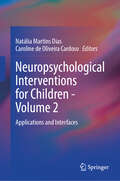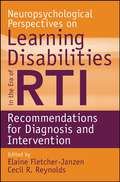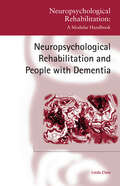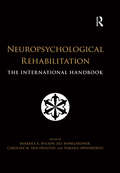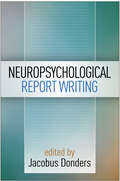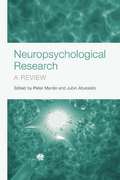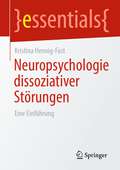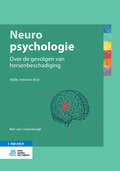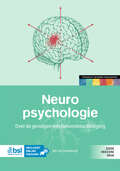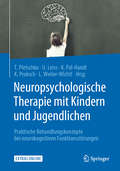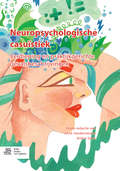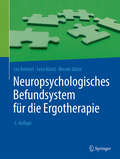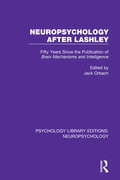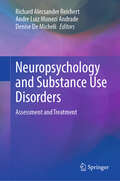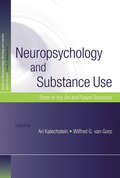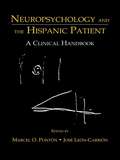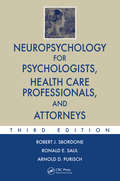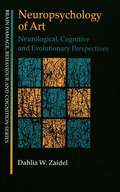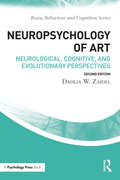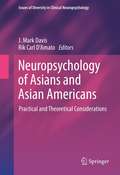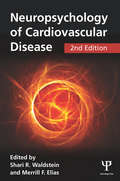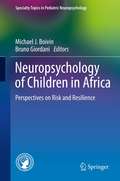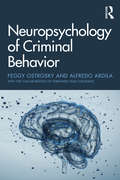- Table View
- List View
Neuropsychological Interventions for Children - Volume 2: Applications and Interfaces
by Caroline de Oliveira Cardoso Natália Martins DiasThis book is the second of two volumes that aim to serve as a comprehensive guide for professionals working with neuropsychological interventions especially designed for children. This second volume complements the theoretical and practical foundations presented in the first volume by presenting applications to different clinical conditions and by exploring interfaces of neuropsychology with other areas of research and practice. Chapters in this second volume are divided into two parts. The first part presents a series of case studies, illustrating the practice and experience of neuropsychological rehabilitation and habilitation in different clinical conditions. The second part brings together chapters that discuss the interfaces of neuropsychology with different areas, which can use its knowledge and interventions (such as school neuropsychology) or which can be used as strategies within neuropsychological intervention or even compose inter and transdisciplinary partnerships in the work of promotion, stimulation, or cognitive remediation, such as the use and role of music, games and play, mindfulness, and transcranial direct current stimulation. So, chapters in this second part highlight the interfaces with other approaches, knowledges or disciplines. Originally published in Portuguese and now available in English, Neuropsychological Interventions for Children – Volumes 1 and 2 will be of interest to professionals working with neuropsychology in clinical and school contexts. It will also be useful in neuropsychology teaching contexts (specialization courses in neuropsychology and related areas) and for students and professionals in interface areas, such as Psychology, Education, Speech Therapy, Occupational Therapy among others. The translation of the original Portuguese version of this book into English was done with the help of artificial intelligence. A subsequent human revision was done primarily in terms of content.
Neuropsychological Neurology
by A. J. LarnerEssential to the management of patients suffering from neurological disorders is an understanding of the cognitive aspects of these conditions. This book begins with an outline of the various cognitive domains and how they can be tested, before covering in depth the cognitive deficits seen not only in prototypical neurodegenerative cognitive disorders (Alzheimer's disease, frontotemporal dementias, Huntington's disease, prionoses), but also in other common neurological disorders which may be complicated by cognitive impairment (stroke, multiple sclerosis, Parkinson's disease, brain tumours). This book is an essential reference text for all neurologists, not just those with an interest in cognitive disorders; and for general physicians and specialists who deal with any endocrine, metabolic, vascular, or infective disorders which may compromise cognitive function. Practitioners of professions allied to medicine which involve contact with cognitively impaired patients will also find this text useful.
Neuropsychological Perspectives on Learning Disabilities in the Era of RTI
by Elaine Reynolds Fletcher-Janzen Cecil R.An insightful look at the role of neuroscience and neuropsychology as it relates to Response to Intervention (RTI) in learning disability diagnosis, treatment, and policy reform Neuropsychological Perspectives on Learning Disabilities in the Era of RTI is a revolutionary new volume presenting the latest research--in question-and-answer format--from leading scholars about the contributions of neuroscience and neuropsychology as it relates to Response to Intervention (RTI) in learning disability identification, diagnosis, and recommended interventions. This collective work includes contributions from more than thirty neuroscientists, neuropsychologists, clinical psychologists, and school psychologists with training in brain-behavior relationships, who explore the answers to questions including: How do you reconcile RTI as a means of diagnosis of learning disability with knowledge from the clinical neurosciences?? What do you think neuroscience has to offer laws and policies associated with learning disability determination? What do you think neuroscience has to offer the assessment and identification of learning disabilities? What role does neurocognitive science play in designing interventions in the context of RTI? What role does neuropsychology have to play in the diagnosis of learning disability? Featuring contributions from leaders in the field of neuropsychology and school psychology, and with a Foreword from Sally Shaywitz, Neuropsychological Perspectives on Learning Disabilities in the Era of RTI illuminates the contributions of neuro-science and neuropsychology to learning disability identification and current educational reform.
Neuropsychological Rehabilitation
by Barbara A. Wilson Fergus Gracey Jonathan J. Evans Andrew BatemanAfter an introduction to the current theories and research findings related to brain injury rehabilitation, this text presents 20 case studies of adults who sustained severe brain damage caused by traumatic head injuries, encephalitis, stroke, hypoxia and other conditions. Problems that follow such injuries are analyzed in detail; these include loss of self-care skills, memory impairment, and language, reading, visuoperceptual and behavioral difficulties. The chapters describe the lifestyle of each individual before the onset of brain damage and the subsequent symptoms, neuropsychological assessment, rehabilitation, and long-term outcome of their condition. Most chapters include a report by the patient and/or family member, thus enhancing the reader's understanding of the predicaments faced by brain-injured individuals as they learn to cope with traumatic changes in lifestyle. Although improvement for those with severe brain injuries is slow and limited, the patients described in the book made some progress after their admission to rehabilitation services. The exhaustive analysis of each case and a step-by-step description of management will serve as an inspiring and informative guide for students, professionals and other caregivers.
Neuropsychological Rehabilitation and People with Dementia (Neuropsychological Rehabilitation: A Modular Handbook)
by Linda ClareRehabilitation provides a core concept around which to organise support, intervention and care for people with impairments in memory and other cognitive functions. This book introduces a conceptual framework and rationale for the application of a neuropsychological rehabilitation approach for people with dementia, helping them to manage, bypass or overcome these problems and experience optimum well-being. Methods and techniques of cognitive rehabilitation are described and the process of goal-setting is discussed in detail, showing how effective strategies may be linked to form an individualised, goal-oriented approach to intervention. The application of a rehabilitation approach in real-life contexts is explored, demonstrating the role and value of neuropsychological rehabilitation within a holistic, psychotherapeutic framework of care and support. This overview of the neuropsychological rehabilitation approach to dementia care will be of great interest to psychologists as well as to those studying or practising in the area.
Neuropsychological Rehabilitation: The International Handbook (Studies On Neuropsychology, Neurology And Cognition Ser.)
by Barbara A. Wilson Jill Winegardner Caroline M. van Heugten Tamara OwnsworthThis outstanding new handbook offers unique coverage of all aspects of neuropsychological rehabilitation. Compiled by the world’s leading clinician-researchers, and written by an exceptional team of international contributors, the book is vast in scope, including chapters on the many and varied components of neuropsychological rehabilitation across the life span within one volume. Divided into sections, the first part looks at general issues in neuropsychological rehabilitation including theories and models, assessment and goal setting. The book goes on to examine the different populations referred for neuropsychological rehabilitation and then focuses on the rehabilitation of first cognitive and then psychosocial disorders. New and emerging approaches such as brain training and social robotics are also considered, alongside an extensive section on rehabilitation around the world, particularly in under-resourced settings. The final section offers some general conclusions and an evaluation of the key issues in this important field. This is a landmark publication for neuropsychological rehabilitation. It is the standalone reference text for the field as well as essential reading for all researchers, students and practitioners in clinical neuropsychology, clinical psychology, occupational therapy, and speech and language therapy. It will also be of great value to those in related professions such as neurologists, rehabilitation physicians, rehabilitation psychologists and medics.
Neuropsychological Report Writing (Evidence-Based Practice in Neuropsychology)
by Jacobus DondersAll neuropsychologists need to know how to produce evidence-based reports. This book brings together experts to provide an in-depth guide to high-quality report writing in a range of contexts, including evaluations of older adults, psychiatric patients, those with complex medical conditions, schoolchildren, and others. It reviews the fundamental elements of a clinical neuropsychological report and shows how to tailor findings, conclusions, and recommendations to particular audiences, such as referring physicians, school professionals, and legal decision makers. Of special utility, every chapter features excerpts of sample reports, including examples of strong and poor documentation of the same material.
Neuropsychological Research: A Review
by Jubin AbutalebiIn a broad sense, neuropsychology stands for the branch of brain sciences that aims to understand how the structure and function of the brain relate to specific cognitive and psychological processes. The idea of developing a research field somewhere between neurology and cognitive psychology emerged in the 1960s as a result of studies conducted by both disciplines which, although using different methodologies and tools, were analysing the same issues. Neuropsychology particularly puts emphasis on the clinical and experimental study of the cognitive effects of brain injury or neurological diseases, taking models of normal cognitive functioning into account. Neuropsychological Research: A Review provides a meticulous overview of what has been achieved in the field of cognitive neuropsychology from its early beginnings in the 1960s and 1970s to the present day. Authors include some of the pioneers involved in the genesis of neuropsychology as an independent and distinct field of neuroscience. The comprehensive coverage includes language disorders, skilled movement disorders, recognition disorders, attentional and executive disorders, visuo-perceptual disorders, memory disorders, and neurodegenerative diseases. This fascinating text forms an enjoyable tribute to the rich heritage of neuropsychology, and will be essential reading for researchers and students of neuropsychology, clinical psychology, cognitive psychology, and behavioural neuroscience.
Neuropsychologie dissoziativer Störungen: Eine Einführung (essentials)
by Kristina Hennig-FastIm Bereich der dissoziativen Störungen führt die WHO mit der ICD-11 markante Anpassungen der Klassifikation ein, die unter anderem die jüngeren Forschungsergebnisse der letzten Jahre berücksichtigen. Vor allem im Bereich der Neuropsychologie und Neurowissenschaften zeigt eine Vielzahl von Publikationen, dass kognitive Störungen und deren zugrundliegende neuronalen Veränderungen eine wesentliche Rolle beim Entstehen und beim Aufrechterhalb der Symtpome spielen.Auf der Basis der neuen Erkenntnisse und der Neuerungen werden Behandler:innen auf der Basis der epidemiologischen, äthiologischen und modelltheoretischen Grundlagen mit der Rolle der neurokognitiven Veränderungen und den sich daraus entwickelnden Modellen vertraut gemacht. Die Klassifikation, Diagnostik und Behandlung der Störungen wird in diesem Rahmen beleuchtet. Anhand von Fallbeispielen und Exkursen werden die dissoziativen Störungen praktisch verständlich.
Neuropsychologie: Over de gevolgen van hersenbeschadiging
by Ben Van CranenburghDit boek helpt professionals (in opleiding) om hersenaandoeningen beter te begrijpen. Het bespreekt systematisch welke stoornissen en problemen kunnen ontstaan door hersenbeschadiging, ontwikkelingsstoornissen en degeneratieve aandoeningen. De problemen die de patiënt in zijn dagelijks leven ervaart, zijn daarbij steeds de leidraad. Het boek is met name bedoeld voor therapeuten, artsen, psychologen, verpleegkundigen en studenten. Neuropsychologie, Over de gevolgen van hersenaandoeningen maakt deel uit van de een zesdelige serie ‘Toegepaste neurowetenschappen’. Het boek is gebaseerd op jarenlang onderzoek en talrijke patiëntencasussen. Het boek gaat in op wetenschappelijke ontwikkelingen in de klinische neuropsychologie én beschrijft vragen en situaties uit de praktijk. De eerste hoofdstukken bespreken de uiteenlopende oorzaken en gevolgen van hersenaandoeningen. Vervolgens wordt elke stoornis, zoals afasie en apraxie, uitgewerkt. Ook krijgt u handvatten om in de praktijk een neuropsychologisch onderzoek te doen en krijgt u oefeningen aan de hand van casuïstiek. De volgende hoofdstukken gaan in op neuropsychologische aspecten van ontwikkelingsstoornissen, veroudering en degeneratieve ziekten. Ten slotte ziet u zeven praktijkdiagrammen met uitgewerkte voorbeelden die u direct in de klinische praktijk kan gebruiken. Bij het boek hoort ook een online omgeving met vragen en antwoorden, samenvattingen en verwijzingen naar casuïstiek en video’s.Neurowetenschapper Ben van Cranenburgh studeerde geneeskunde in Amsterdam en was als wetenschappelijk medewerker verbonden aan onder meer het Nederlands Centraal Instituut voor Hersenonderzoek en het Revalidatie Centrum Amsterdam. In 1987 richtte hij het Instituut voor toegepaste neurowetenschappen (ITON) op, waarvan hij tot op heden directeur is. De stichting ITON biedt nascholingscursussen aan op het gebied van de toegepaste Neurowetenschappen.
Neuropsychologie: Over de gevolgen van hersenbeschadiging
by Ben van CranenburghDit boek biedt inzicht in hersenaandoeningen en de gevolgen ervan voor cognitie, mentale processen en gedrag. Het richt zich op neuropsychologische functiestoornissen door hersenbeschadiging, ontwikkelingsstoornissen en neurodegeneratieve aandoeningen. De nadruk ligt op de gevolgen die patiënten in hun dagelijks leven ervaren. Het boek is bedoeld voor studenten, therapeuten, artsen, psychologen en verpleegkundigen. De eerste hoofdstukken geven een overzicht over de uiteenlopende oorzaken en gevolgen van hersenaandoeningen. Daarna volgt een gedetailleerde uitleg over stoornissen als afasie, apraxie, agnosie, amnesie en neglect, met casuïstiek-oefeningen. In aparte hoofdstukken worden neuropsychologische aspecten van ontwikkelingsstoornissen en neurodegeneratieve ziekten behandeld. Bij dit boek hoort een online platform met extra bijlagen, vragen, samenvattingen, casuïstiek en video’s, plus zeven praktijkdiagrammen voor direct gebruik in de klinische praktijk. Het boek is onderdeel van de zesdelige serie ‘Toegepaste neurowetenschappen’ en is gebaseerd op jarenlange studie en ervaring van de auteur.
Neuropsychologische Therapie mit Kindern und Jugendlichen: Praktische Behandlungskonzepte bei neurokognitiven Funktionsstörungen
by Thomas Pletschko Ulrike Leiss Katharina Pal-Handl Karoline Proksch Liesa J. Weiler-WichtlDas Buch stellt neuropsychologische Interventionen aus der Kinder-und Entwicklungsneuropsychologie vor, die maßgeschneidert auf Kinder mit neurokognitiven Funktionsstörungen angewendet werden können – im klinischen wie im ambulanten Kontext. Sie werden mit ihren Einsatzgebieten anschaulich und konkret vorgestellt anhand zahlreicher Fallbeispiele. Dem Leser wird ein konkretes evidenzbasiertes Behandlungskonzept spezifisch für Kinder und Jugendliche präsentiert, in dem verschiedene Methoden zur Anwendung kommen können.
Neuropsychologische casuïstiek: Verdieping en praktijkgerichte gevalsbeschrijvingen
by J.A.M. Vandermeulen M.M.A. DerixDit boek wil een breed inzicht geven in verschillende gebieden van de klinische neuropsychologie bij volwassenen. Het beoogt relevant te zijn voor (klinisch) neuropsychologen, klinisch psychologen, GZ-psychologen, eerstelijnspsychologen en basispsychologen. Het probeert een intensief blikveld te creëren in het onderzoeksterrein waarbinnen de neuropsychologie meandert. er wordt hiervoor in het boek gebruik gemaakt van casuïstiekbeschrijvingen. Het is in de dagelijkse praktijk juist de casuïstiek die steeds weer opnieuw de aandacht opeist om de 'gewone' en bijzondere neuropsychologische problemen, die zich in het dagelijkse leven kunnen voordoen te verhelderen en oplossingen hiervoor bedenken. KERNDOEL Wij willen een boek aanbieden waarbij in de verschillende hoofdstukken uitgegaan wordt van casuïstiek gericht op volwassenen. Het boek moet als een praktisch instrument gebruikt kunnen worden, dit in tegenstelling tot de vele boeken die als een naslagwerk dienen en uiteindelijk meestal langdurig in de kast staat.
Neuropsychologisches Befundsystem für die Ergotherapie
by Lea Krönert Lena KünzlDieses Arbeitsbuch bietet eine praxisorientierte Anleitung zur Befunderhebung und Dokumentation von neuropsychologischen Störungen. Gemäß der ICF werden dabei vorrangig die Alltagsprobleme der Patient*innen auf Aktivitäts- und Partizipationsebene erfasst. Durch diese Herangehensweise gelingt es mit minimalem Aufwand, eine klare und zielgerichtete Sammlung von relevanten Informationen für die weitere Behandlungsplanung zu erstellen. Aus dem Inhalt: Einführung in die Befundaufnahme, Einschätzung von Störungsbildern und Zielsetzung, Befundung der häufigsten neuropsychologischen Störungsbilder wie Neglect, Gedächtnisstörungen, Störungen der Exekutivfunktionen und Apraxie, weitere Kapitel liefern Informationen zur differenzierten Erfassung von Einschränkungen der Sensorik, Kommunikation und des Umgangs mit Zahlen und Geld, Dokumentationsbögen und Arbeitsmaterialien, neu in der 5. Auflage: komplett überarbeitet, erneuert und neu strukturiert, mit zusätzlichen Assessments sowie einem Kapitel zur Pusher-Symptomatik.
Neuropsychology After Lashley: Fifty Years Since the Publication of Brain Mechanisms and Intelligence (Psychology Library Editions: Neuropsychology #9)
by Jack OrbachOriginally published in 1982, about 50 years after the publication of Lashley’s Brain Mechanisms and Intelligence. The aim of this book was to review Lashley’s major contributions and to trace the development of physiological psychology through the experimental work of Lashley’s students and colleagues and those influenced by Lashley’s writings. The contributors were invited to review their own experimental work in a lecture and to indicate how Lashley’s seminal contributions might have exerted an influence in shaping or directing their thinking. This volume is the result of their efforts.
Neuropsychology and Substance Use Disorders: Assessment and Treatment
by Denise De Micheli Richard Alecsander Reichert Andre Luiz Monezi AndradeThis book is a comprehensive guide for health professionals working with psychoactive drug use and dependence who want to learn the nuts and bolts of the neuropsychology of substance use disorders. It presents the basic foundations of neuropsychology, including a historical overview of studies and research, theoretical and conceptual bases, and practical applications to the area of psychoactive drug use and dependence. It also includes a comprehensive introduction to the history, theoretical models, diagnostic criteria and epidemiology of substance use disorders. With a special focus on practice and applied knowledge, the volume presents the main methods of neuropsychological assessment of substance use disorders and reviews the most important neuropsychological and psychotherapeutic interventions to treat substance use disorders. Additionally, whole sections of the book are dedicated to explaining the impacts of substance use on cognitive and executive functions and the relationship between substance use and mental disorders in adolescence. Finally, the book also includes brief introductions to the neurobiology of substance use disorders and to research methodologies for studying the neuroscience of psychoactive substance use. Neuropsychology and Substance Use Disorders: Assessment and Treatment will be an invaluable resource for health and care professionals from different areas, such as clinical psychology, psychiatry, nursing and social woacrk, who are looking for a friendly introduction to the neuropsychology of substance use disorders. It will also be a helpful tool for graduate and undergraduate psychology students interested in specializing in this field of knowledge and practice.
Neuropsychology and Substance Use: State-of-the-Art and Future Directions (Studies on Neuropsychology, Neurology and Cognition)
by Ari Kalechstein Wilfred G. van GorpSubstance use continues to be a major public health problem, and the ramifications of this are manifold. For instance, at present, on a yearly basis, the total economic cost of substance misuse is literally hundreds of billions of dollars. These costs are related to a number of factors, including, but not limited to, treatment and prevention, reduced job productivity and/or absenteeism, interdiction by the criminal justice, and incarceration. There are many more psychosocial consequences of substance misuse, and these have been well–documented over the past four to five decades; in contrast, with the exception of alcohol, the effects of substance misuse on the brain have received attention only in the past 10 to 15 years. An emerging body of literature has reported on the effects of various drugs on neuropsychological functioning, including benzodiazepines, cocaine, marijuana, MDMA, methamphetamine, nicotine, and opioids. Despite the fact that the neuropsychological consequences of many drugs of abuse are well–documented, to our knowledge, no one had previously published an edited volume that focused exclusively on this issue. Based on this fact, we decided to create a volume that would review the available literature regarding on this topic. Neuropsychology and Substance Misuse: State-of-the-Art and Future Directions explores cutting-edge issues, and will be of interest to clinical neuropsychologists who require the latest findings in this increasingly important area of neuropsychology.
Neuropsychology and the Hispanic Patient: A Clinical Handbook
by Marcel O. Pontón José León-CarriónBy 2010, 15% of the U.S. population will be Hispanic. Neuropsychology and the Hispanic Patient: A Clinical Handbook brings together internationally recognized authorities to address the cultural, methodological, research, and forensic issues that must be considered by neuropsychologists seeking to be maximally effective in their work with members of the fastest-growing American minority group. It includes: * useful assessment decision trees; * summaries of normative data; * descriptions of tests available in Spanish; * extensive HIV and pediatric references; and * numerous charts and illustrations. Reflecting the latest demographic information and covering the developmental spectrum from pediatric to geriatric, this landmark Handbook will become an indispensable reference tool for clinicians and researchers alike.
Neuropsychology for Psychologists, Health Care Professionals, and Attorneys (Rob & Smith's Operative Surgery Series)
by Robert J. Sbordone Ronald E. Saul Arnold D. PurischExtensively revised and expanded, this third edition of Neuropsychology for Psychologists, Health Care Professionals, and Attorneys provides a clear, concise, and comprehensive discussion of neuropsychology, outlining its purpose, use, and historical development. It covers the anatomy of the brain, a wide variety of neurobehavioral disorders, compr
Neuropsychology of Art: Neurological, Cognitive and Evolutionary Perspectives (Brain, Behaviour and Cognition)
by Dahlia W. ZaidelThe significance of art in human existence has long been a source of puzzlement, fascination, and mystery. In Neuropsychology of Art, Dahlia W. Zaidel explores the brain regions and neuronal systems that support artistic creativity, talent, and appreciation.Both the visual and musical arts are discussed against a neurological background. Evidence from the latest relevant brain research is presented and critically examined in an attempt to clarify the brain-art relationship, language processing and visuo-spatial perception. The consequences of perceptual problems in famous artists, along with data from autistic savants and established artists with brain damage as a result of unilateral stroke, dementia, or other neurological conditions, are brought into consideration and the effects of damage to specific regions of the brain explored. A major compilation of rare cases of artists with brain damage is provided and the cognitive abilities required for the neuropsychology of art reviewed.This book draws on interdisciplinary principles from the biology of art, brain evolution, anthropology, and the cinema through to the question of beauty, language, perception, and hemispheric specialization. It will be of interest to advanced students in neuro-psychology, neuroscience and neurology, to clinicians and all researchers and scholars interested in the workings of the human brain.
Neuropsychology of Art: Neurological, Cognitive, and Evolutionary Perspectives (Brain, Behaviour and Cognition)
by Dahlia W. ZaidelFully updated, the second edition of Neuropsychology of Art offers a fascinating exploration of the brain regions and neuronal systems which support artistic creativity, talent and appreciation. This landmark book is the first to draw upon neurological, evolutionary, and cognitive perspectives, and to provide an extensive compilation of neurological case studies of professional painters, composers and musicians. The book presents evidence from the latest brain research, and develops a multidisciplinary approach, drawing upon theories of brain evolution, biology of art, art trends, archaeology, and anthropology. It considers the consequences of brain damage to the creation of art and the brain’s control of art. The author delves into a variety of neurological conditions in established artists, including unilateral stroke, dementia, Alzheimer’s Disease, Parkinson’s Disease, and also evidence from savants with autism. Written by a leading neuropsychologist, Neuropsychology of Art will be of great interest to students and researchers in neuropsychology, cognitive psychology, neuroscience, and neurology, and also to clinicians in art therapy.
Neuropsychology of Asians and Asian-Americans: Practical and Theoretical Considerations
by J. Mark Davis Rik Carl D'AmatoNeuropschology with Asians and Asian Americans Practical and Theoretical Considerations J. Mark Davis and Rik Carl D'Amato, editors The challenge of cultural competence for health providers is more than the recognition of other ethnicities: it entails the balancing of group and individual factors to apply relevant information in diagnostic and therapeutic settings. Particularly in need of culturally appropriate services are Asians and Asian Americans, populations that are diverse, growing, and underserved by Asian practitioners. Neuropsychology with Asians and Asian Americans takes cultural neuroscience to new levels in its variety and usefulness. Focusing on the largest groups of Far East and Southeast Asian descent, this leading-edge reference examines the influence of culture on psychological processes and identifies sociocultural factors as they influence neurological aspects of client presentation. This expert coverage goes beyond well-known constructs of "collectivism" and "family orientation" toward establishing an evidence base crucial to understanding, assessing, and treating Asian and Asian American clients, including: Linguistic factors and language assessment of Asians.Society and acculturation in Asian and Asian American communitiesMental illness from Asian and Asian American perspectives.Understanding cognitive differences across the lifespan: comparing Eastern and Western culturesClinical interviews and qualitative assessment with Asian clientsNeuropsychological test selection with Asian clients Unique in its scope and detail, Neuropsychology with Asians and Asian Americans is a necessary resource for neuropsychologists and rehabilitation specialists as well as social workers and clinical, counseling, and school psychologists.
Neuropsychology of Cardiovascular Disease
by Shari R. Waldstein Merrill F. EliasCardiovascular disease (CVD) is the leading cause of morbidity and mortality in the United States and most westernized nations. Both CVDs and their risk factors confer substantial risk for stroke and dementia, but are also associated with more subtle changes in brain structure and function and cognitive performance prior to such devastating clinical outcomes. It has been suggested that there exists a continuum of brain abnormalities and cognitive difficulties associated with increasingly severe manifestations of cardiovascular risk factors and diseases that precede vascular cognitive impairment and may ultimately culminate in stroke or dementia. This second edition examines the relations of a host of behavioral and biomedical risk factors, in addition to subclinical and clinical CVDs, to brain and cognitive function. Associations with dementia and pre-dementia cognitive performance are reported, described, and discussed with a focus on underlying brain mechanisms. Future research agendas are suggested, and clinical implications are considered. The volume is a resource for professionals and students in neuropsychology, behavioral medicine, neurology, cardiology, cardiovascular and behavioral epidemiology, gerontology, geriatric medicine, nursing, adult developmental psychology, and for other physicians and health care professionals who work with patients with, or at risk for, CVDs.
Neuropsychology of Children in Africa
by Bruno Giordani Michael J. BoivinIncreasingly, global humanitarian efforts are focusing on improving the lives of children. And among the developing world, the African nations are particularly affected by extreme weather conditions, devastating pandemics, and armed conflict. Neurocognitive science offers significant avenues toward bringing needed aid to the continent while creating a template for helping children worldwide. The studies in Neuropsychology of Children in Africa clearly illustrate how the brain develops and adjusts in the face of adversity. Contributors span assessment approaches and public health risk factors, and represent established topics and emerging lines of research, including biocultural constructs and genomic technologies. Together, these chapters argue for methodology that is culturally sensitive, scientifically rigorous, consistent, and sustainable. And although the focus is pediatric, the book takes a lifespan approach to prevention and intervention, modeling a universal framework for understanding neurocognitive development. Included in the coverage: Assessment of very young children in Africa in the context of HIV.Psychosocial aspects of malnutrition among African children.Assessment of neuropsychological outcomes in pediatric severe malaria.Neurodisability screening using the Ten Questions questionnaire.The neuropsychology of sickle cell disease in West African children.Computerized Cognitive Rehabilitation Therapy for African children. As a guide to current findings or a springboard for new studies, Neuropsychology of Children in Africa is a necessary reference for researchers, policymakers, and diverse professionals in global aid organizations, and across the discipline.
Neuropsychology of Criminal Behavior
by Alfredo Ardila Feggy OstroskyThis book draws on findings from psychology, neurology, and genetics, to offer a multi-dimensional analysis of criminal behavior. It explores the biological bases of emotions such as aggression, anger, and hostility and how they-- combined with social psychological influences, such as family history and environmental conditions-- may lead to violence. Specific case studies, including serial killings, mass murders, family violence, cannibalism, and hitmen, are referenced throughout, providing real-world examples of these theories in action. Issues of free will and the law are discussed as well as suggestions for curbing violent behavior.
